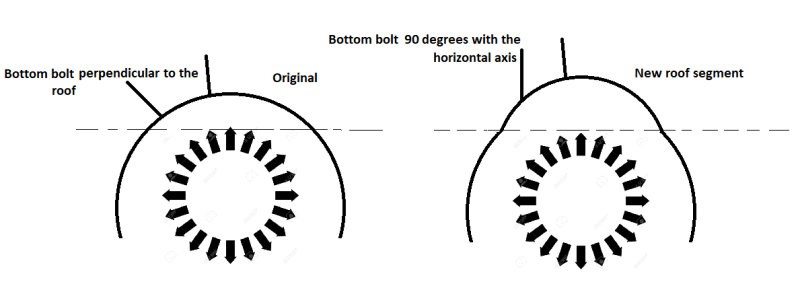bojoka4052
Mechanical
Design 1 has a pretty even circle geometry, Design 2 has a new roof segment which is longer than the roof segment of Design 1.
In the middle there is a suface load pushing everything outwards. The structure is pinned at the bottom.
The problem is that all the bolts are supposed to be in tension due to the self weight of the roof, but with the new roof segment my bottom bolt is in compression. I tried to move it up and rotate it to be 90 degrees with the horizontal axis, but still the bolt is slightly in compression.
I am thinking this is due to the increased surface which gives higher overall surface load, which pushes the roof up so much that it does not matter where I place the bottom bolt. But on the other side I should get more self weight of the roof pushing it downwards aswell, but I guess this is not enough to compensate.
Is there any way for me to get my bottom bolt to be in tension? Would it help to add more bolts (im guessing not)? I tried rotating and placing it higher but that didnt seem to help. Would love to hear any inputs or suggestions you guys might have.

Left is Design 1, Right is Design 2.
In the middle there is a suface load pushing everything outwards. The structure is pinned at the bottom.
The problem is that all the bolts are supposed to be in tension due to the self weight of the roof, but with the new roof segment my bottom bolt is in compression. I tried to move it up and rotate it to be 90 degrees with the horizontal axis, but still the bolt is slightly in compression.
I am thinking this is due to the increased surface which gives higher overall surface load, which pushes the roof up so much that it does not matter where I place the bottom bolt. But on the other side I should get more self weight of the roof pushing it downwards aswell, but I guess this is not enough to compensate.
Is there any way for me to get my bottom bolt to be in tension? Would it help to add more bolts (im guessing not)? I tried rotating and placing it higher but that didnt seem to help. Would love to hear any inputs or suggestions you guys might have.

Left is Design 1, Right is Design 2.
